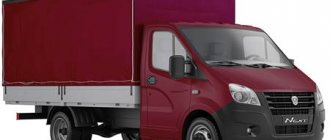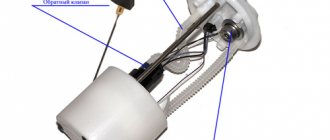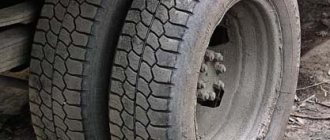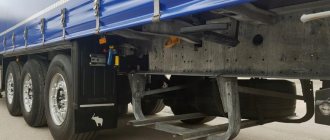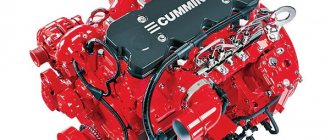GAZ 3302 car - the second life of the “lorry”
In the early nineties, in the motor transport market, the empty segment of small-tonnage cars was filled by a new model - the GAZ 3302 car, called the Gazelle.
Specialists from the Gorky Automobile Plant again created a car that became the second legendary “lorry.” The design of the GaZ 3302 made it possible to place the power units and driver’s cabin as compactly as possible. This made it possible to install a large cargo platform on the relatively small body of the GAZ 3302. At the same time, the car turned out to be easy to control and maneuverable.
The car was immediately liked by both representatives of air transport companies and industrial enterprises, as well as private entrepreneurs, farmers and businessmen. The GAZ 3302 model, whose fuel consumption (11.5 liters per 100 km) does not exceed Volgov’s, immediately became an indispensable assistant in industry, trade and agriculture. The Gazelle has truly become a people's car, just as the GAZ AA lorry was once. The small size of the GAZ 3302 and small turning radius (5.5 m) made it popular for use in large cities, ports, warehouses and household plots.
Kamaz 55111: technical characteristics, load capacity, wiring diagram (photos, videos, reviews).
Brief description and technical characteristics of Kamaz 4310 on this page.
Electrical equipment of Gazelle
Traditionally, the electrical equipment of the Gazelle requires special attention. Starting from the 50th thousand, troubles may appear. Moreover, you should be prepared not only for the breakdown of such a small thing as a plastic turn switch, but also for the circuit of the starter being shorted, the generator burning, or the ignition coil breaking. Many drivers complain that the rear license plate lights have to be changed before each technical inspection, because all the dirt and salt from the rear side gets stuck on them, so they don’t last for more than a year.
Characteristics and design of the GAZ 3302 car
Thanks to the high-quality work of the designers of the Gorky Automobile Plant, the GaZ 3302 device turned out to be very easy to maintain and repair.
Initially, the car received a power unit that met international standards. The first cars were equipped with a GAZ 3302 (ZMZ-4025) gasoline engine. Its displacement (2.445) and compression ratio (6.7) made it possible to develop power up to 90 horsepower. Later, the Gazelle began to be equipped with the ZMZ-4026 engine (100 hp), and then with the ZMZ-406 engine family. A diesel engine was also installed on this model, but it never became popular, as it required modifications to the suspension, transmission and braking system. Models with a diesel engine and an upgraded transmission are now being produced. The GAZ 3302 gearbox has not undergone any significant changes over the years of production, since it was originally designed very well. This is a three-shaft, five-speed and fully synchronized design with optimal gear ratios for this type of machine (I - 4.05; II - 2.34; III - 1.395; IV - 1.0; V - 0.849; 3X - 3.51 ). The main gearbox of GAZ 3302 is hypoid type with a gear ratio of 5.125. Such gear ratios made the Gazelle capable of dynamic acceleration and overcoming steep climbs even with a maximum load (1500 kg).
The reliable braking system and powerful frame of the GAZ 3302, combined with a low loading height, have made the car the most popular light-duty truck. For urban operation, no special permits are required, since the car can drive under signs prohibiting the movement of trucks. The maximum speed of 115 km/h makes it possible to make both short and long intercity flights. The comfortable and spacious cabin and ergonomic driver’s seat have pleased everyone who has been driving a Gazelle for many years. The practical instrument panel of the GAZ 3302 makes it possible to maximally control all parameters of the machine’s operation.
Well-deserved popularity in the market is the result of low prices and good quality
The optimal price-quality ratio allows this model, for many years, to maintain its first position in the light truck market in the territory of the former Soviet Union.
Steady popularity is dictated by the low price of the car itself and the availability of spare parts. For example, a GAZ 3302 clutch will cost 2.5 times less than a similar model of a Mercedes, MAN or other truck. The current situation in this market segment indicates the high competitiveness of the Russian truck. In addition to domestic buyers, the model is very popular among motorists in Ukraine, Moldova, Belarus and other post-Soviet countries. The simplicity of the design and easy access to the vehicle components allows you to change the coil, distributor or radiator of the GAZ 3302 in 15-20 minutes, even in road conditions. The highly efficient GAZ 3302 heater is also accessible. Its operation will satisfy users even in severe frosts. A simple electrical circuit of the GAZ 3302 allows you to identify any malfunction during the operation of electrical equipment in a matter of minutes. You can quickly purchase spare parts for the Gazelle, both in real retail outlets and in online auto parts stores.
The positive characteristics of the GAZ 3302 among motorists are based on its high reliability and practicality. The hardworking and fast Gazelle has been successfully operated for two decades in a wide variety of climatic conditions in the Russian Federation and CIS countries. This is the brightest representative of the fifth generation of Gorky light-duty trucks.
Repair and diagnostics of model 3302
Throughout its serial production, the Gazelle was equipped with various engines and a five-speed gearbox. The 4-speed gearbox was installed only on the very first production of the car (until 1995), and the one-piece rear axle was also borrowed from the Volga. But by 1996, bridge 3302 had developed its own original design.
This is what the gearbox looks like for GAZ 3302
Front and rear suspension
The front and rear suspension are leaf springs, both suspensions have hydraulic shock absorbers. In front, the base is the front beam, on which the rotating axles (knuckles) are installed. The steering knuckles are connected to the beam using pins. The beam is attached to the frame through springs with stepladders and nuts. The front suspension is equipped with 2-leaf or 4-leaf springs. The four-leaf spring on the front beam is considered reinforced.
The rear suspension consists of a rear axle, springs and shock absorbers. A standard spring consists of three leaves, another leaf has a spring. There are, respectively, five main leaves on the reinforced spring and three on the suspension.
Breakdowns in the chassis mainly occur due to vehicle overload.
What breakdowns most often occur in the Gazelle chassis:
- Springs sag;
- The spring leaves burst;
- The nuts on the stepladders are loosened;
- At the connection of the front beam with the steering knuckles, the pivot pins and pivot bushings wear out;
- Shock absorbers fail.
Due to the loosening of the stepladder nuts, the bridges may move, so you need to periodically check the tightness; this is also recommended in the repair manual. If you drive for a long time with weakened axles, the central bolt holding the spring leaves together breaks. And then you have to reassemble the entire spring, and this work is quite labor-intensive.
On a kingpin front suspension, it is recommended to periodically inject the pins (fill the pin joint with lubricant).
Diagram of the front beam arrangement on the Gazelle 3302
Shock absorbers also break under heavy load - the hydraulics weaken and the parts lose their elasticity. The Gazelle begins to sway vertically on uneven roads. But changing shock absorbers for gas 3302 is very easy; just unscrew two fastening nuts - one on top and one on bottom.
Brake system
The GAZ 3302 brake system has a standard design and consists of the following elements:
- Brake drums and drum-type pads;
- Main and working brake cylinder;
- Vacuum brake booster;
- Brake hoses and tubes;
- Handbrake system parts.
The handbrake on the Gazelle is of a mechanical type with a drive on the rear pads. The lever is located in the cabin; when it is raised, the handbrake cables are tightened, pushing the brake pads apart and pressing them against the rear drums. The cables are a weak point and periodically become sour in the cages, so it is necessary to periodically check their condition.
The main cylinder with the vacuum booster often fails.
It should be noted that for some reason these parts often break on all GAZ models - both on trucks and on Volgas.
Air entering the brake system leads to reduced braking efficiency. In this case, you should bleed the brakes.
Diagram of the Gazelle brake system
Rear axle and gearbox
The rear axle itself is designed quite well, but the quality of GAZ parts does not always meet the necessary standards. One of the “sores” of the bridge is the buzzing main pair. Even a correctly adjusted gap does not always guarantee quiet operation of the transmission unit.
This is what the rear axle Gas 3302 looks like
The five-speed gearbox 3302 is very similar in design to the Volgov gearbox; they differ in gear ratios. The housing of the boxes is the same, but the shafts and first gear gear have a different number of teeth. If desired, the GAZ 3110 gearbox can be installed and operated on a Gazelle with minor modifications, only the first gear in this case will be higher, and accordingly, the car will move off faster.
Engine ZMZ 402
The most common engine that GAZ engines could boast of was the ZMZ 402. It was produced from the beginning of 1980 until 2006.
Now you can find it exclusively in a maintained form. This GAZ engine is the most common, as it has been produced for more than 20 years, which makes it easy to find the necessary spare parts and carry out repairs.
In terms of technical characteristics, it is not particularly different from its predecessors:
- The engine cylinder is made of aluminum, the power supply system is carburetor.
- Maximum engine capacity – 2115 cm3.
- This engine has quite high fuel consumption - up to 14 liters per 100 km in the city.
- One of the main advantages of this engine is its versatility, thanks to which it can be used on almost all GAZ cars.
Breakdowns and repairs of the ZMZ 402 engine
Despite the high quality and mass production of the Gazelle ICE engine, breakdowns still occur. These include the following malfunctions:
- One of the most fragile parts in the ZMZ 402 engine is the crankshaft oil seal. It is made from ordinary rope, pre-impregnated in graphite lubricant. The strength limit of such a part is up to 2500 rpm. If you exceed this figure, the crankshaft oil seal will simply begin to leak oil out. In order to avoid such unpleasant situations with ZMZ 402, the stuffing box should be replaced with a better one made of durable material;
- Abnormal vibration, unnatural sounds, and jerking may occur when the engine is idling. Such signs of malfunction may appear due to wear of the carburetor, since its design is initially crooked and is not the best solution implemented in Gazelle engines. Due to this feature, fuel is supplied to the engine cylinders in uneven parts, which leads to the malfunction described above;
- The occurrence of unhealthy sounds in the engine during its operation. Basically, the owner of a car with a GAZ engine is faced with knocking in the engine, which indicates a faulty fuel supply through the valve. In order to avoid such troubles, valve clearances should be adjusted in a timely manner. Basically, this car needs engine maintenance after every 15,000 km. If the knocking does not occur due to a crooked valve, then you should turn your attention to the connecting rod bearings or the camshaft.
Due to its wide distribution, almost any breakdown of the ZMZ 402 can be corrected; it is enough to find out the cause of the malfunction and carry out high-quality repairs or replacement of the damaged part. This is why gazelle engines are not often completely replaced due to breakdown.
Modifications of ZMZ
There are also a large number of modified versions of ZMZ 402 engines, which were mass-produced and produced for cars of the same name.
The most common modifications include the following:
It is this modification that can most often be found among motorists in our country. It is installed on the Volga and works with 92 gasoline;
Not the best engineering solution for low-cost cars, as it contains a number of complex engineering solutions, such as a modified carburetor and an improved crankshaft.
Such innovations were supposed to increase the performance, efficiency, and reduce the toxicity of the GAZ engine. But in reality, not everything turned out so well, there was no expected efficiency, and the entire design required significant modifications;
It has no special differences from the 402 model, but was developed and used for cars of the Gazelle family.
Main components of the brake system
Vacuum booster
Vacuum booster:
- A1, A2, A3, A4 and A5 - cavities of the vacuum amplifier;
- A6 - holes;
- check valve;
- sealing sleeve;
- pushers;
- adjusting bolt;
- pistons;
- lid;
- diaphragms;
- diaphragms;
- thrust ring;
- pistons;
- piston flange;
- amplifier housing;
- guide rings;
- sealing cuffs;
- filter;
- valve body;
- pushers;
- pistons;
- valve diaphragm;
- screw;
- jet washer;
- spring;
- piston connector
A two-chamber vacuum booster is installed between the brake pedal and the main cylinder (Fig. 7.3), which is activated by the vacuum in the intake pipe of a gasoline engine or by the vacuum created by a vacuum pump on cars with a diesel engine.
At the threaded end of the piston connector 23, a secondary piston 5 is secured with a nut, and a piston 10 with a flange 11, diaphragms 8 and 19 are attached to the flange part with three bolts that are screwed into the valve body 16.
In the valve body 16, two screws 20 secure a pusher 17 with a piston 18 and a filter 15. A reaction washer 21 is installed in the flange 11 of the piston, through which the total force from the pusher 17, directly connected to the brake pedal, and from both pistons of the amplifier is transmitted to the pusher 3. To release the system, a gap is required between pusher 3 and the primary piston of the master cylinder. This is ensured using adjusting bolt 4. The head of the bolt should be recessed 1.35-1.65 mm relative to the mating plane of the cover to which the master cylinder flange is attached.
Engine ZMZ 406
This is the next stage in the development of engines for the Gazelle, which replaced the ZMZ 402.
Despite the slight differences in numbers between them, this motor has undergone dramatic changes compared to its predecessor.
The main differences include the following changes:
- changing the location of camshafts;
- 16 valve engine;
- hydraulic compensators are installed, which avoids the constant need for their adjustment;
- a significantly improved timing drive, the service life of which is 100,000 km, but in most cases can withstand loads twice as large. The engine camshaft is driven by gears with helical teeth. At the same time, a steel gear is mounted on the crankshaft, and a textolite gear with a cast iron hub is mounted on the distribution shaft to ensure silent operation.
But despite the general improvement in design and the use of more reliable components, this GAZ engine also has a number of serious drawbacks, due to which it is necessary to monitor the hydraulic tensioners and the condition of the chains quite often.
At the same time, it is difficult to overestimate innovations in the production of GAZ engines, especially when comparing the ZAZ 406 with the classic ZAZ 402.
Modification ZMZ 406
There are only three modifications of the ZMZ 406 engine:
The GAZ car engine runs on 76 gasoline and is of the carburetor type. At the moment it is rare, as it was produced in smaller quantities than other modifications and is now obsolete;
One of the most common modifications of the ZAZ engine. This Gazelle engine is also used on the Volga. Has an injection type of operation;
One of the latest modifications of the above-mentioned engine, running on 92 gasoline. This GAZ engine operates on a carburetor circuit.
Breakdowns of ZMZ 406
This type of motor may have the following malfunctions:
- Despite the stronger material used for hydraulic tensioners - metal chains, they also have some disadvantages that the driver may not have encountered when using a rope transmission. The timing chains on the engine can become jammed over time. Such a malfunction leads to unhealthy noise, vibrations appear in the operation of the engine, leading to the destruction of the shoe or the chain jumping;
- overheating of the ZMZ 406 engine. One of the most common malfunctions that appears when the radiator is dirty or the thermostat is malfunctioning. It is worth replacing the coolant with a new one;
- Due to wear of the hydraulic compensator, knocking noise may occur in the engine. This type of malfunction is most often encountered by owners of the ZMZ 406 and the GAZ 3307 engine. This malfunction also appears when connecting rod bearings, pistons and piston pins break.
Engine UMZ 4216
UMZ 4216 is one of the most modern modifications of motors from this manufacturer.
Its good specifications and high reliability are proven by many positive reviews among motorists. The main difference from older models is a significantly increased engine volume, improved exhaust valves, which have become 3 mm larger compared to the previous model, and an injection type of operation and gasoline supply.
Also based on the UMZ 4216, a series of Evotek engines was developed. If we compare this engine with the ZMZ 402, the UMZ 4216 has blocks of significantly increased strength; instead of wet liners, dry and thin analogues began to be installed, the cylinders became larger in diameter and are now 100 mm versus 92 mm used on the ZMZ 402.
Also at the Ulyanovsk Motor Plant, where engines with the abbreviation UMZ were produced, a diesel engine for the Gazelle is assembled.
The main breakdowns and malfunctions with this motor are not particularly different from the problems described above for a number of other engines. This is due to the fact that there are no global differences between the ZMZ motor series and the UMZ motor series, and they have a similar structure and operating principle.
In order for the GAZ engine to work as long as possible, the valve clearances should be checked and adjusted every 10,000 km, which will help avoid serious damage. The same rules apply to the repair and operation of the GAZ 3307 engine, which is common among business and government enterprises that have trucks from this manufacturer in their fleet.
Story
The need for a compact truck was dictated by new market relations that were actively developing in the country in the early 1990s. The constant increase in the number of small cargo transportation led to a sharp increase in demand for small commercial vehicles, which the Russian automotive industry could not satisfy. There was simply no affordable and high-quality product on the market. The GAZ group was the first to respond to the emerging need by introducing the GAZelle line. The empty niche was supposed to be filled with a very interesting development - the GAZ 3302 light-duty truck.
The appearance of a fundamentally new model in 1994 changed the mechanism of intercity and urban transportation, significantly simplifying it. The technical characteristics of the GAZ 3302 ensured rapid growth and broad opportunities. The new design principle became a turning point in the understanding of cargo transportation, and the model itself became one of the most popular on the Russian market for many years.
The design of the GAZ 3302 could hardly be called stunning. The streamlined cabin is simple in shape without any interesting elements. The model received a standard appearance and was initially equipped with an old-fashioned radiator grille, complemented by rectangular headlights. The developers' priority was functionality.
In the summer of 1995, the Gorky Automobile Plant produced a small series of all-wheel drive GAZ 33027 with a dual-pitch rear tire and permanent all-wheel drive. The modification was intended to work in difficult areas and on dirt roads.
In 2002, an extended version of the GAZ 330202 appeared, initially equipped exclusively with tow truck platforms and auto bench bodies. Subsequently, standard add-ons began to be installed on it. Modifications with increased length made it possible to partially close the niche between the Valdai and GAZelle models.
In 2003, the GAZ 3302 series underwent a minor restyling, which made the design more attractive.
We had to wait 7 years for the next update. Global modernization led to a name change. The car became known as “GAZelle-Business”. The developers borrowed the cabin design from the Ford Transit model, which had a positive effect on the level of comfort and attractiveness. The interior space of the GAZelle-Business has increased (3 people could easily fit in the cabin). Visibility has also improved. At the same time, the Gorky Automobile Plant did not refuse to produce the first modification with a more affordable price.
In 2011, production of a 2-ton model with a reinforced rear axle began.
Back in 1995, the development of a gas-cylinder version of the GAZ 33205 for the CIS countries began, but large-scale production of the model was postponed several times. The car entered production only in the spring of 2010. Previously, all gasified modifications of GAZelle were equipped with gas cylinder equipment through small specialized companies for individual orders. At the same time, the consumer lost the factory warranty, which negatively affected the demand for this model.
Gazelle body
The hood and engine compartment parts are most susceptible to rust . In winter it is damp and warm there, the most optimal conditions for rust. Over 4 years of operation, the inner panels of the hood can turn into dust, and within 5 years it can completely rust. But this does not yet threaten the new Gazelle NEXT.
The designers, apparently, did not even think about the durability of the wheel arches, fenders, doors and running boards . Therefore, do not be alarmed if the internal surfaces begin to peel off during the first winter. To avoid these problems, you should clean off the resulting rust, cover it with lubricant and install wheel arch liners .
The sides of the Gazelle body seem to be well ventilated, so they should last forever. But it was not there. Most of all it goes to the license plate lights and the rear side. By spring they turn into rusty lumps, so they need to be replaced.
If the Gazelle is loaded not only by forklifts, but also often by overhead loading, the awning is subject to serious deformation. The maximum awning lasts for four years, but this is conditional. After two years of operation, it begins to leak water, and after another two, it finally cracks.
Other engines
The following engines are installed on this vehicle:
- UMZ 4216;
- ZMZ 402;
- ZMZ 406;
- ZMZ 405;
- GAZ-51.52;
- Diesel engine cummins ISF 2.8 (GAZelle) and ISF 3.8 (Valdai);
- ZMZ 4021 (Volga) 76;
- ZMZ 4052 (Volga) 92B;
- ZMZ 511 (GAZ-53.3307);
- MMZ D245.7E2 without compressor with generator (GAZ 3308,3309 with hydraulic brakes);
- UMZ 3302 dv 274 GUR Euro-4 EvoTech;
- It is also possible to install a Japanese engine on Gazelle Business.
Each of these engines has its own characteristics, which you should learn about when purchasing or operating this car, which will allow you to find out which engine is better for the modern motorist.
Cabin Gazelle
The Gazelle's cabin is fraught with one peculiarity. As soon as the sliding glass of the door freezes a little in winter, an inexperienced passenger, trying to open it, will break the window regulator. The rollers are made of plastic, so they burst immediately, and they are sold only complete with the mechanism. In the window lift units, the quality of the plastic is disgusting; the plastic tube, running up and down, tends to break. The cable immediately weakens and comes off the drum groove, jamming the entire mechanism. It should be noted that the left and right window regulators are not interchangeable. You can easily modify the assembly yourself: simply replace the plastic shells with metal ones.
We examined the main problems of parts and components of the cargo Gazelle. The main advantage of this car is, of course, low cost . Therefore, decide for yourself which truck to choose.
